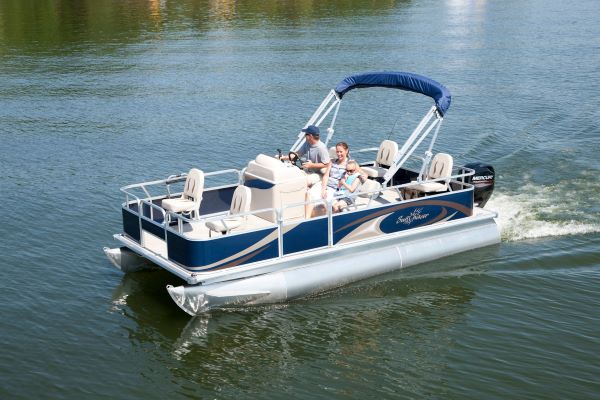Let’s say you’re in the market for a pontoon and you’re itching to get on the water. But there are so many choices regarding size, style, use, aesthetics, performance and more, taking the next step isn’t easy. And then there’s this: “Do I need two tubes or three tubes on my pontoon. What’s the difference?”
The answers to those common questions might be simpler than you think.
Pontoons of one form or another have been around for centuries. They were first used to support bridges 800 years ago in Europe, and early Polynesians built small vessels on them when they realized two logs were better than one when it came to buoyancy and stability. Evolutions of those primitive boats eventually inspired modern-day catamarans and, more recently, pontoon boats.
 Credited with building and marketing the first modern pontoon boat was Minnesota farmer Ambrose Weeres, who in 1951 constructed a platform over two barrels, attached a simple but effective steering system, named his creation The Empress and opened the first pontoon boat company. Weeres Pontoons has since built 30,000 boats and remains in business today!
Credited with building and marketing the first modern pontoon boat was Minnesota farmer Ambrose Weeres, who in 1951 constructed a platform over two barrels, attached a simple but effective steering system, named his creation The Empress and opened the first pontoon boat company. Weeres Pontoons has since built 30,000 boats and remains in business today!
In 1957, Ernie and Pete Harris introduced the Harris Floteboat in Ft. Wayne, Indiana, expanding and improving on Weeres’ designs. They initially used airplane tanks for pontoons, then discarded them and created their own flat-nosed steel pontoons. They added a motor mount to their boat so the engine could be raised and lowered.
Convincing consumers to come to the Harris boat lot proved challenging, but sales skyrocketed when they took their boats to lakes and offered free demonstration rides to local boaters. Within a few years they had added comfortable furniture to their boats and they couldn’t make them fast enough.
Pontoon popularity grew throughout the 1900s, then exploded in the early 2000s. Today, pontoons remain a hot commodity, due largely to the many activities they accommodate. They’re considered ideal for cruising, fishing, family outings and just getting out on the water.
But back to the question at hand: How do you determine the number of pontoon tubes that will best suit your boating activities? The choice, according to boat builders and dealers, depends on whether your boating will be limited to pleasure cruising or will include performance-based activities, such as pulling skiers and tubers.
If cruising calm waters, taking in the sights and relaxing is your goal, two tubes will work perfectly and will be less expensive than three.
However, if watersports or activities requiring higher-horsepower engines are in your plans, consider pontoons with three tubes; they typically provide better balance and weight distribution, deliver a more stable ride, and accommodate heavier and more powerful engines. They also perform better in choppy water, and the improved weight distribution and buoyancy deliver better handling at higher speeds while the larger deck accommodates more people.
Harris pontoon boats are specifically designed with a slightly lower center tube that allows the boats to bank in turns, similar to deck boats and fiberglass boats.
As soon as you determine how important speed, power and extra stability are to your pontoon future, it’s time to go shopping!

